Information System Design: Android Bookshop Mobile Application
VerifiedAdded on 2020/03/01
|13
|1539
|54
Project
AI Summary
This document outlines the graphical user interface (GUI) design for an Android mobile application developed for a bookshop, emphasizing usability and adherence to design principles. The project scope encompasses the design of key pages like register, login, navigation, categories, display results, and contact us. It details the evaluation methodology based on ISO/IEC 9126-1 Product quality specifications, focusing on navigability, accessibility, interactivity, organization, helpfulness, and interoperability. The document also describes the evaluation experiments, including unit, integration, and GUI tests, and provides an analysis methodology using data flow diagrams (DFDs), entity relationship diagrams (ERDs), structure charts, data dictionaries, decision trees, and structured English (pseudo code). The goal is to enable users to search for books and place orders efficiently, ensuring a user-centered design that meets customer needs and ethical considerations like privacy and security. The document concludes with a list of references to support the design and methodology used.
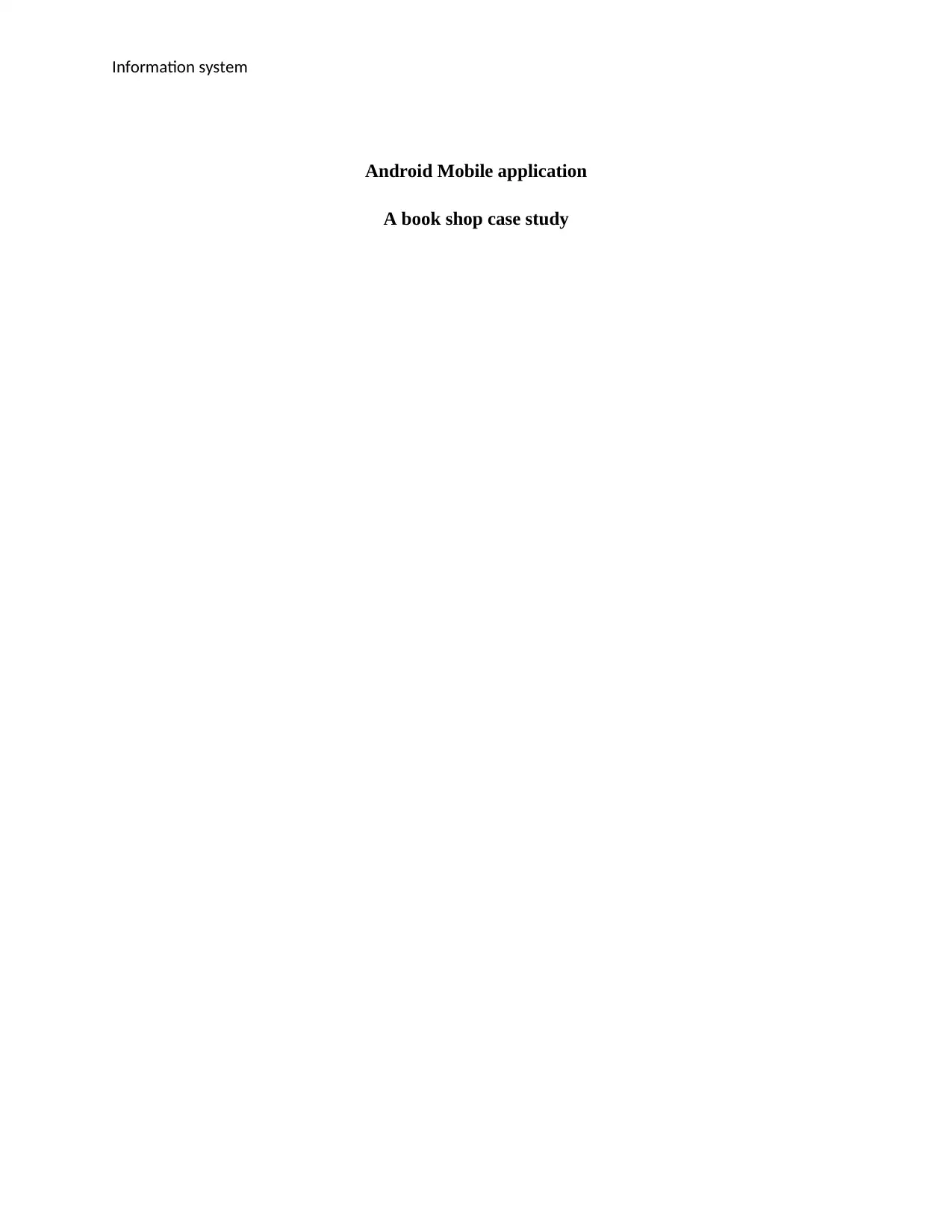
Information system
Android Mobile application
A book shop case study
Android Mobile application
A book shop case study
Paraphrase This Document
Need a fresh take? Get an instant paraphrase of this document with our AI Paraphraser
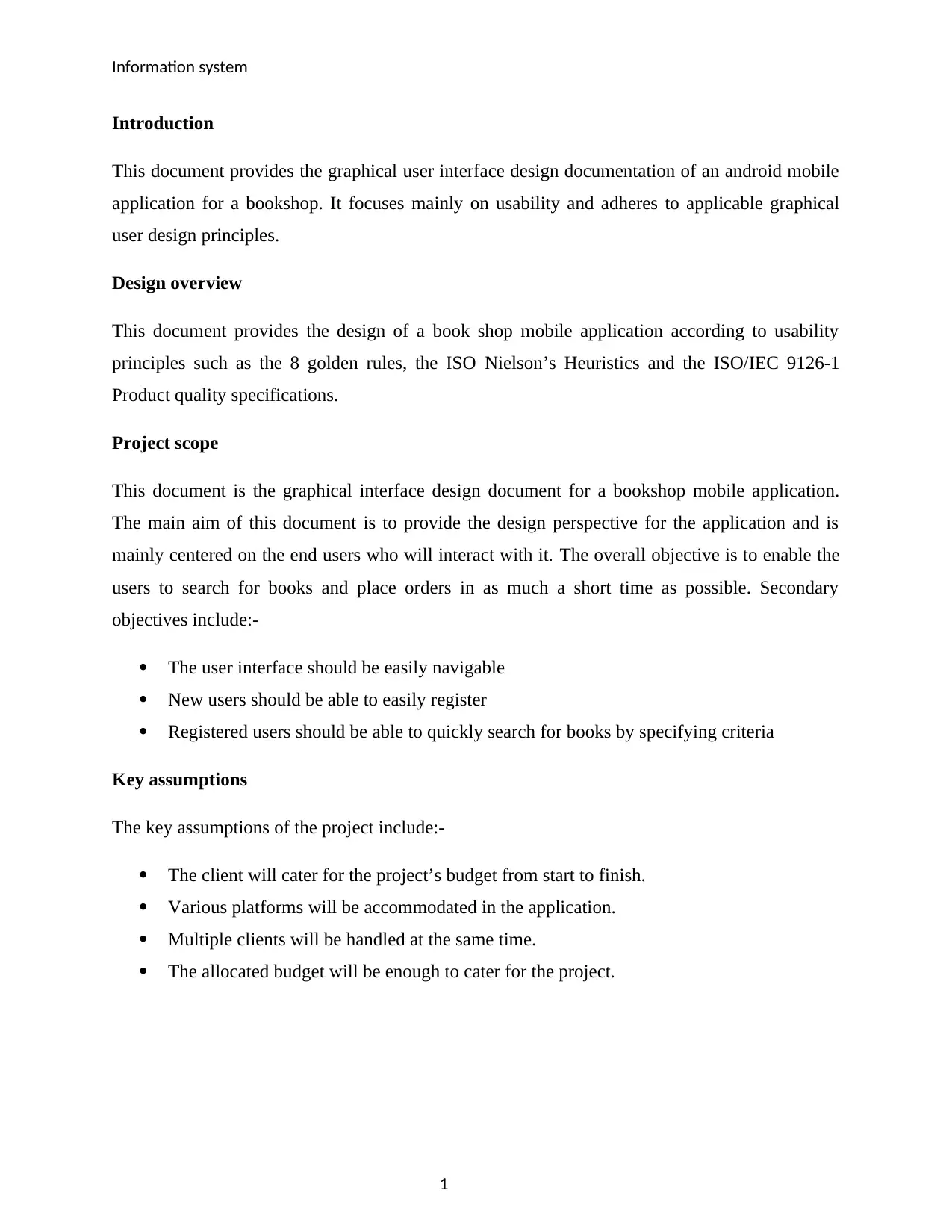
Information system
Introduction
This document provides the graphical user interface design documentation of an android mobile
application for a bookshop. It focuses mainly on usability and adheres to applicable graphical
user design principles.
Design overview
This document provides the design of a book shop mobile application according to usability
principles such as the 8 golden rules, the ISO Nielson’s Heuristics and the ISO/IEC 9126-1
Product quality specifications.
Project scope
This document is the graphical interface design document for a bookshop mobile application.
The main aim of this document is to provide the design perspective for the application and is
mainly centered on the end users who will interact with it. The overall objective is to enable the
users to search for books and place orders in as much a short time as possible. Secondary
objectives include:-
The user interface should be easily navigable
New users should be able to easily register
Registered users should be able to quickly search for books by specifying criteria
Key assumptions
The key assumptions of the project include:-
The client will cater for the project’s budget from start to finish.
Various platforms will be accommodated in the application.
Multiple clients will be handled at the same time.
The allocated budget will be enough to cater for the project.
1
Introduction
This document provides the graphical user interface design documentation of an android mobile
application for a bookshop. It focuses mainly on usability and adheres to applicable graphical
user design principles.
Design overview
This document provides the design of a book shop mobile application according to usability
principles such as the 8 golden rules, the ISO Nielson’s Heuristics and the ISO/IEC 9126-1
Product quality specifications.
Project scope
This document is the graphical interface design document for a bookshop mobile application.
The main aim of this document is to provide the design perspective for the application and is
mainly centered on the end users who will interact with it. The overall objective is to enable the
users to search for books and place orders in as much a short time as possible. Secondary
objectives include:-
The user interface should be easily navigable
New users should be able to easily register
Registered users should be able to quickly search for books by specifying criteria
Key assumptions
The key assumptions of the project include:-
The client will cater for the project’s budget from start to finish.
Various platforms will be accommodated in the application.
Multiple clients will be handled at the same time.
The allocated budget will be enough to cater for the project.
1
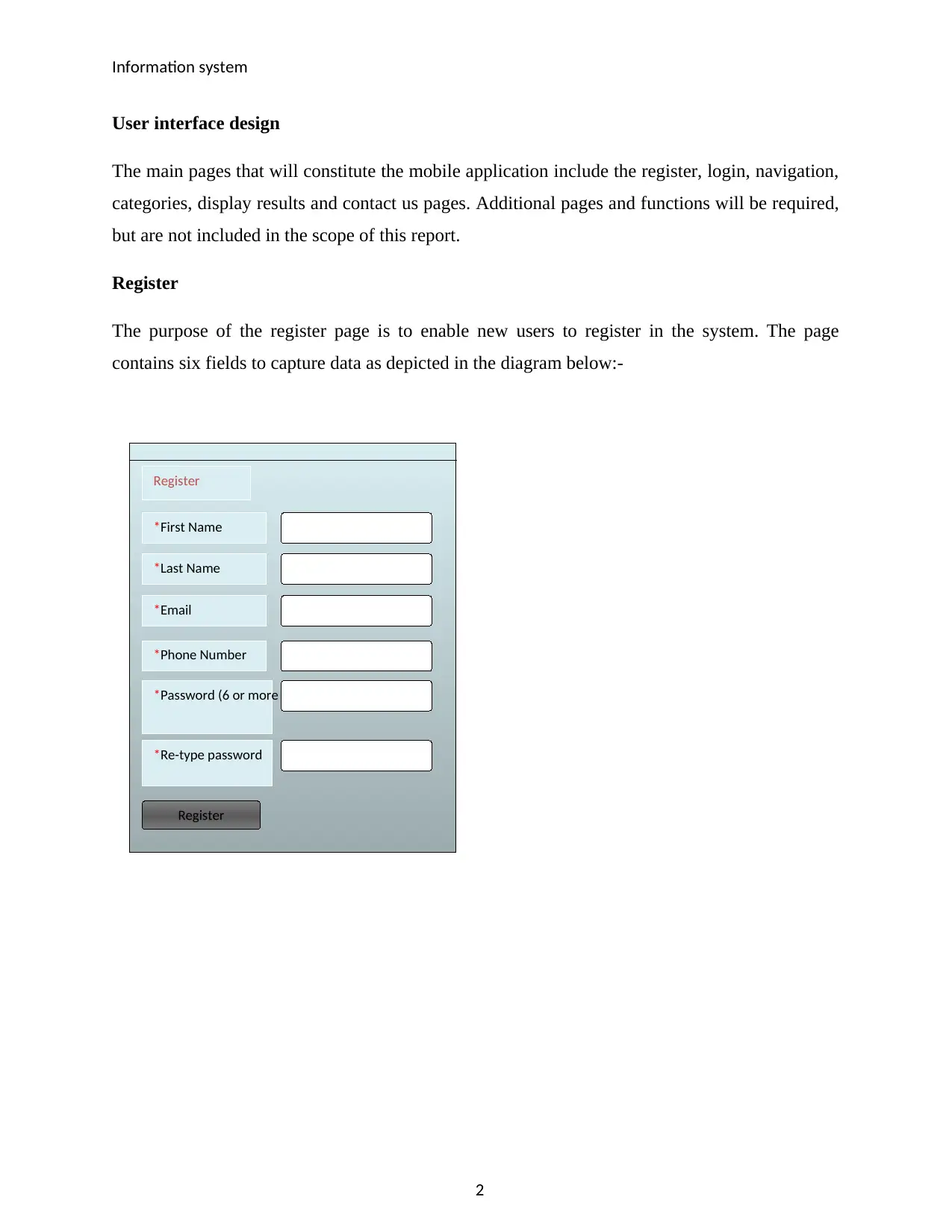
Register
*First Name
*Last Name
*Email
*Password (6 or more characters)
*Re-type password
*Phone Number
Register
Information system
User interface design
The main pages that will constitute the mobile application include the register, login, navigation,
categories, display results and contact us pages. Additional pages and functions will be required,
but are not included in the scope of this report.
Register
The purpose of the register page is to enable new users to register in the system. The page
contains six fields to capture data as depicted in the diagram below:-
2
*First Name
*Last Name
*Password (6 or more characters)
*Re-type password
*Phone Number
Register
Information system
User interface design
The main pages that will constitute the mobile application include the register, login, navigation,
categories, display results and contact us pages. Additional pages and functions will be required,
but are not included in the scope of this report.
Register
The purpose of the register page is to enable new users to register in the system. The page
contains six fields to capture data as depicted in the diagram below:-
2
⊘ This is a preview!⊘
Do you want full access?
Subscribe today to unlock all pages.

Trusted by 1+ million students worldwide
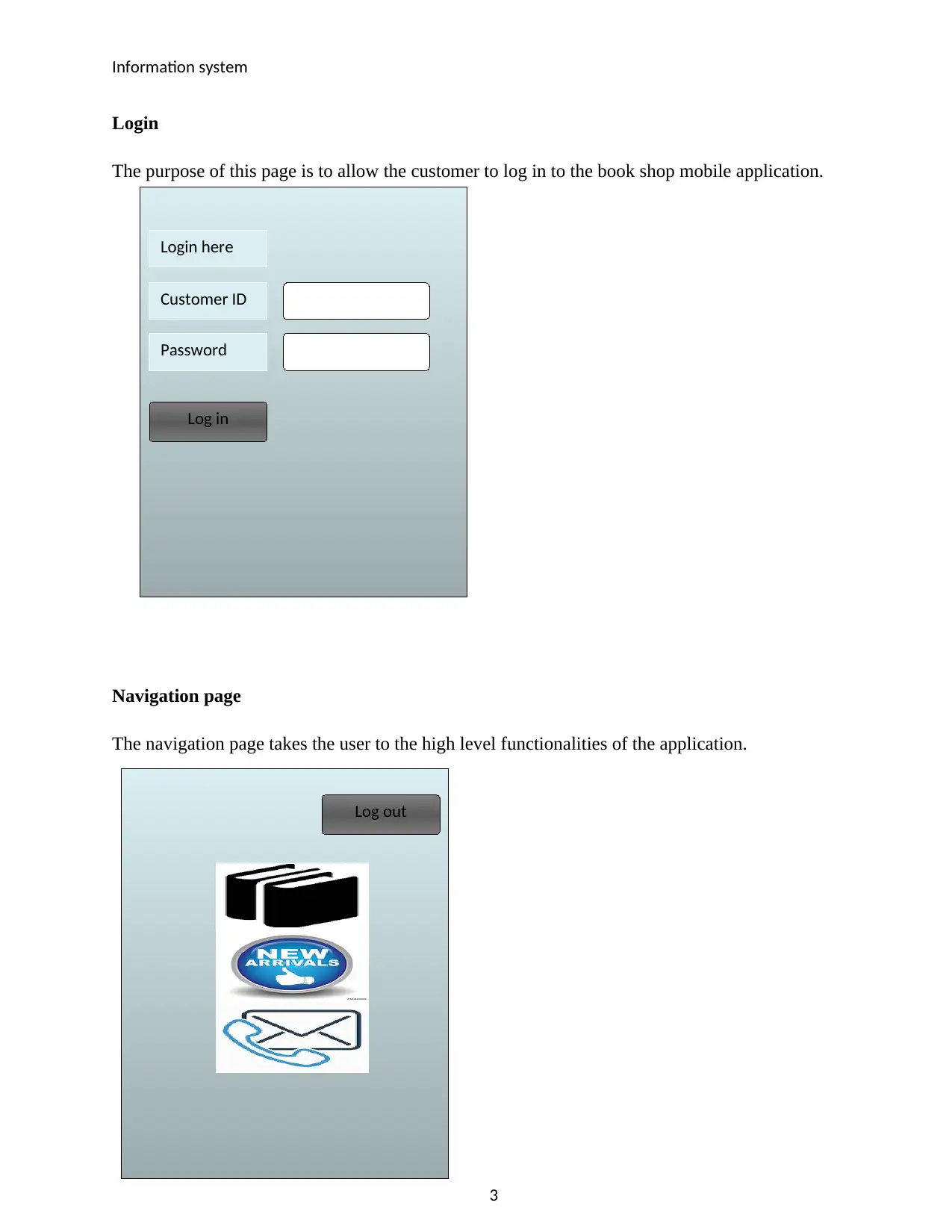
Customer ID
Password
Login here
Log in
Log out
Information system
Login
The purpose of this page is to allow the customer to log in to the book shop mobile application.
Navigation page
The navigation page takes the user to the high level functionalities of the application.
3
Password
Login here
Log in
Log out
Information system
Login
The purpose of this page is to allow the customer to log in to the book shop mobile application.
Navigation page
The navigation page takes the user to the high level functionalities of the application.
3
Paraphrase This Document
Need a fresh take? Get an instant paraphrase of this document with our AI Paraphraser
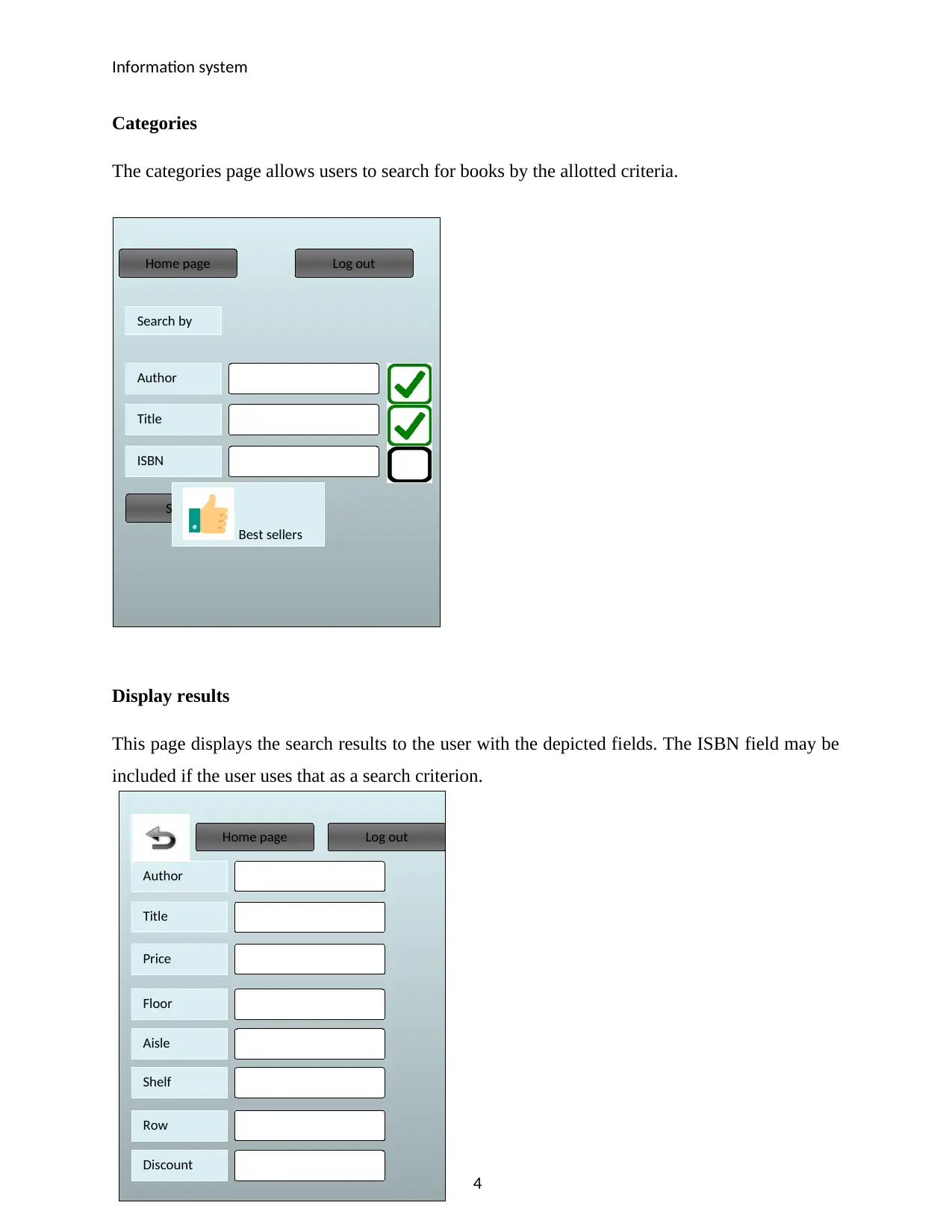
Search by
Author
Title
Log out
ISBN
Search
Home page
Author
Title
Log out
Price
Aisle
Shelf
Row
Floor
Discount
Home page
Information system
Categories
The categories page allows users to search for books by the allotted criteria.
Display results
This page displays the search results to the user with the depicted fields. The ISBN field may be
included if the user uses that as a search criterion.
Best sellers
4
Author
Title
Log out
ISBN
Search
Home page
Author
Title
Log out
Price
Aisle
Shelf
Row
Floor
Discount
Home page
Information system
Categories
The categories page allows users to search for books by the allotted criteria.
Display results
This page displays the search results to the user with the depicted fields. The ISBN field may be
included if the user uses that as a search criterion.
Best sellers
4
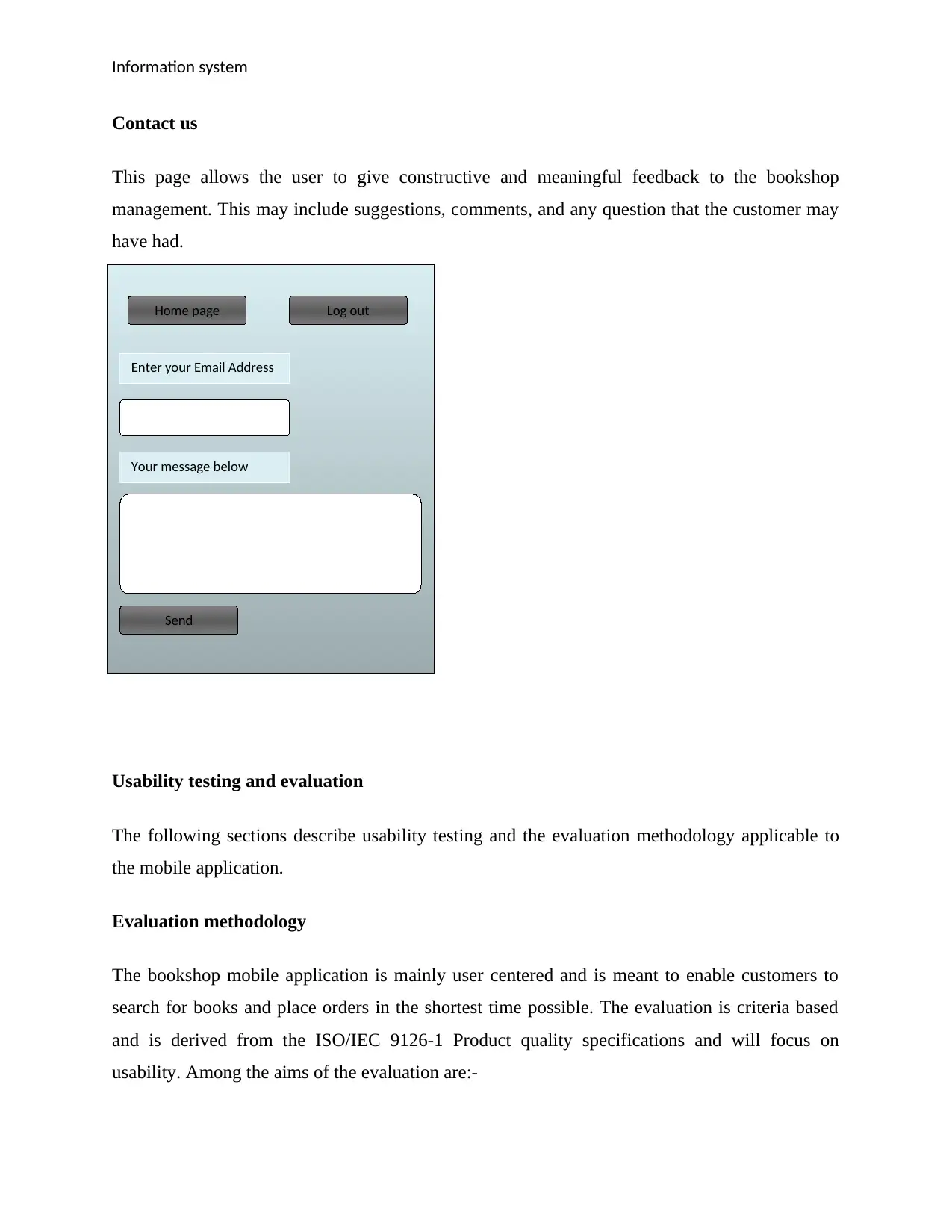
Enter your Email Address
Your message below
Log out
Send
Home page
Information system
Contact us
This page allows the user to give constructive and meaningful feedback to the bookshop
management. This may include suggestions, comments, and any question that the customer may
have had.
Usability testing and evaluation
The following sections describe usability testing and the evaluation methodology applicable to
the mobile application.
Evaluation methodology
The bookshop mobile application is mainly user centered and is meant to enable customers to
search for books and place orders in the shortest time possible. The evaluation is criteria based
and is derived from the ISO/IEC 9126-1 Product quality specifications and will focus on
usability. Among the aims of the evaluation are:-
Your message below
Log out
Send
Home page
Information system
Contact us
This page allows the user to give constructive and meaningful feedback to the bookshop
management. This may include suggestions, comments, and any question that the customer may
have had.
Usability testing and evaluation
The following sections describe usability testing and the evaluation methodology applicable to
the mobile application.
Evaluation methodology
The bookshop mobile application is mainly user centered and is meant to enable customers to
search for books and place orders in the shortest time possible. The evaluation is criteria based
and is derived from the ISO/IEC 9126-1 Product quality specifications and will focus on
usability. Among the aims of the evaluation are:-
⊘ This is a preview!⊘
Do you want full access?
Subscribe today to unlock all pages.

Trusted by 1+ million students worldwide
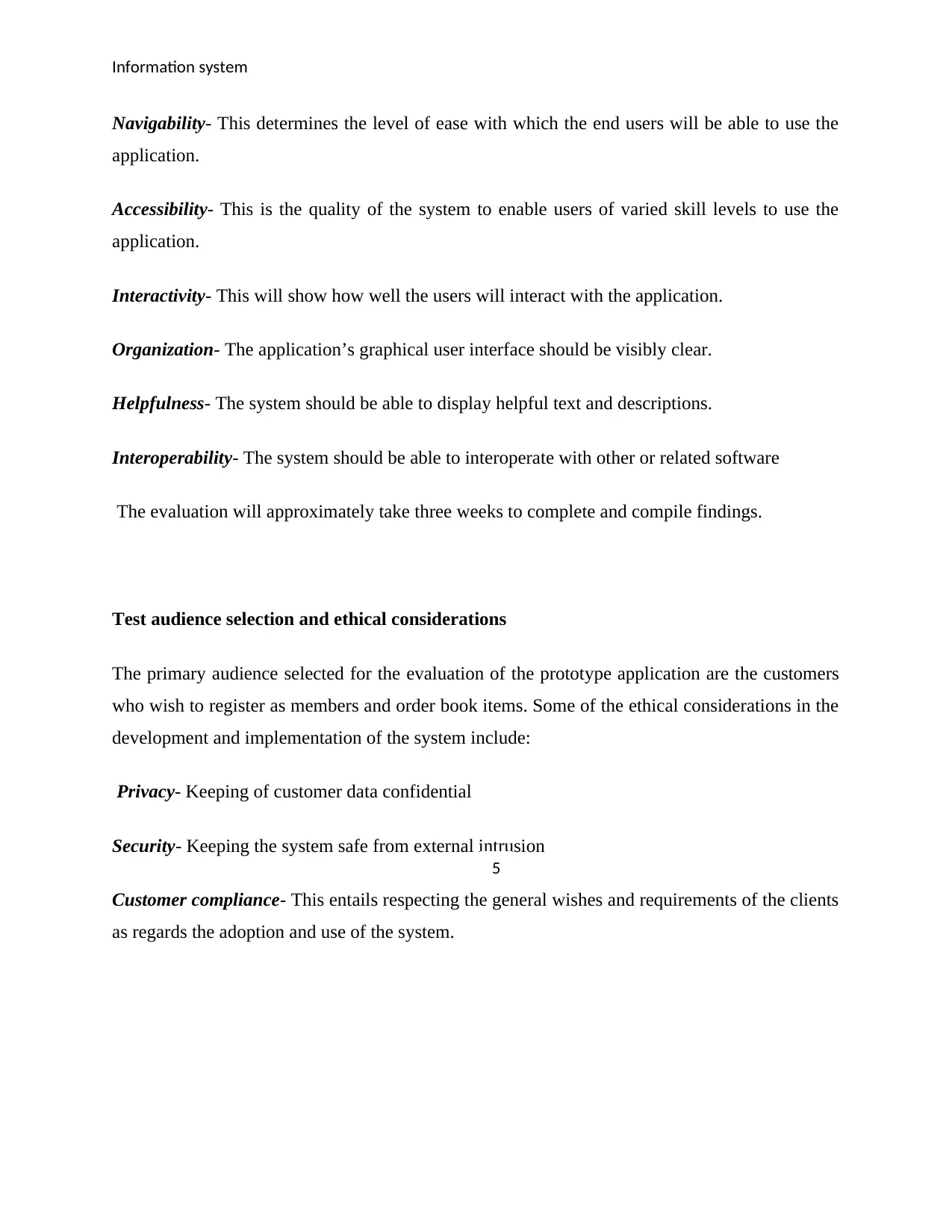
Information system
Navigability- This determines the level of ease with which the end users will be able to use the
application.
Accessibility- This is the quality of the system to enable users of varied skill levels to use the
application.
Interactivity- This will show how well the users will interact with the application.
Organization- The application’s graphical user interface should be visibly clear.
Helpfulness- The system should be able to display helpful text and descriptions.
Interoperability- The system should be able to interoperate with other or related software
The evaluation will approximately take three weeks to complete and compile findings.
Test audience selection and ethical considerations
The primary audience selected for the evaluation of the prototype application are the customers
who wish to register as members and order book items. Some of the ethical considerations in the
development and implementation of the system include:
Privacy- Keeping of customer data confidential
Security- Keeping the system safe from external intrusion
Customer compliance- This entails respecting the general wishes and requirements of the clients
as regards the adoption and use of the system.
5
Navigability- This determines the level of ease with which the end users will be able to use the
application.
Accessibility- This is the quality of the system to enable users of varied skill levels to use the
application.
Interactivity- This will show how well the users will interact with the application.
Organization- The application’s graphical user interface should be visibly clear.
Helpfulness- The system should be able to display helpful text and descriptions.
Interoperability- The system should be able to interoperate with other or related software
The evaluation will approximately take three weeks to complete and compile findings.
Test audience selection and ethical considerations
The primary audience selected for the evaluation of the prototype application are the customers
who wish to register as members and order book items. Some of the ethical considerations in the
development and implementation of the system include:
Privacy- Keeping of customer data confidential
Security- Keeping the system safe from external intrusion
Customer compliance- This entails respecting the general wishes and requirements of the clients
as regards the adoption and use of the system.
5
Paraphrase This Document
Need a fresh take? Get an instant paraphrase of this document with our AI Paraphraser
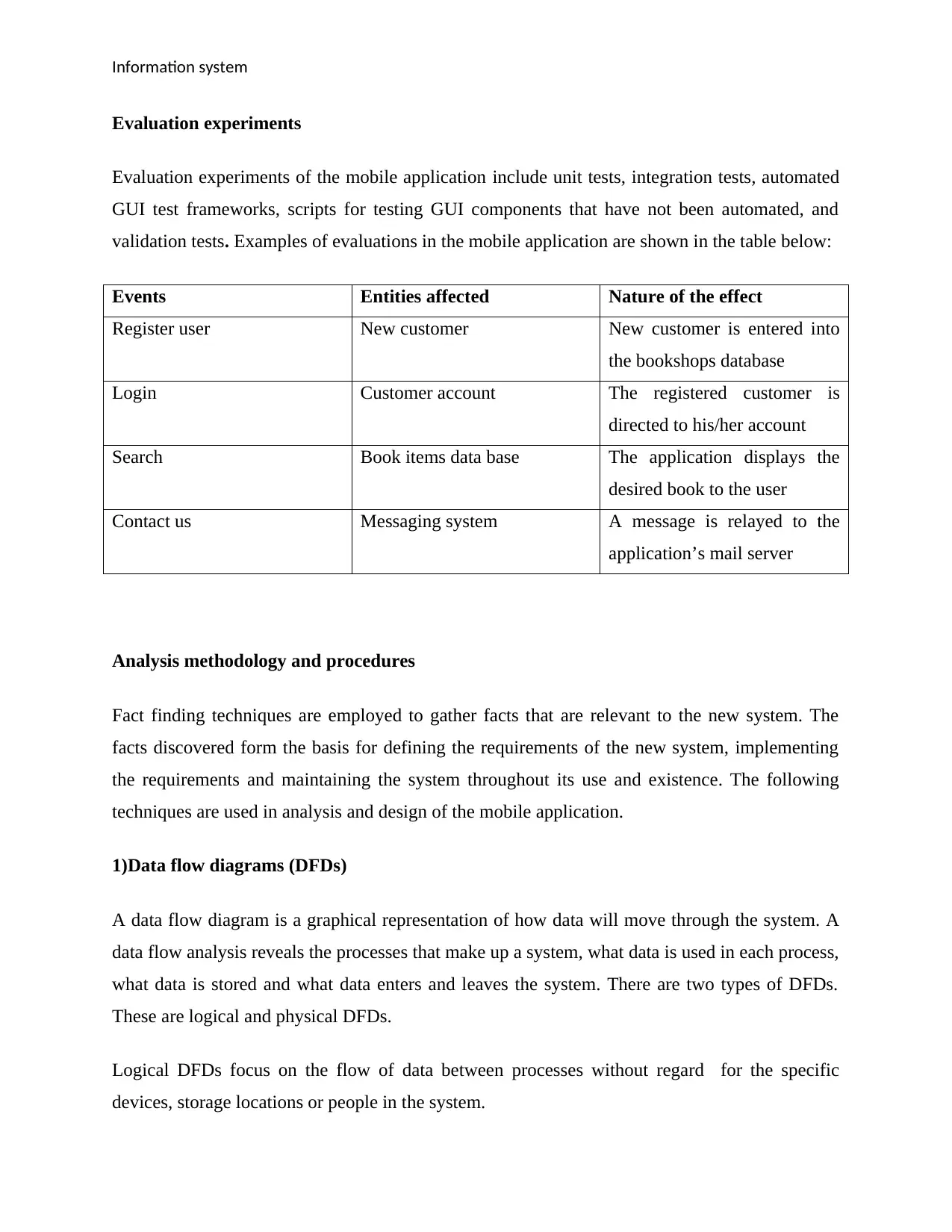
Information system
Evaluation experiments
Evaluation experiments of the mobile application include unit tests, integration tests, automated
GUI test frameworks, scripts for testing GUI components that have not been automated, and
validation tests. Examples of evaluations in the mobile application are shown in the table below:
Events Entities affected Nature of the effect
Register user New customer New customer is entered into
the bookshops database
Login Customer account The registered customer is
directed to his/her account
Search Book items data base The application displays the
desired book to the user
Contact us Messaging system A message is relayed to the
application’s mail server
Analysis methodology and procedures
Fact finding techniques are employed to gather facts that are relevant to the new system. The
facts discovered form the basis for defining the requirements of the new system, implementing
the requirements and maintaining the system throughout its use and existence. The following
techniques are used in analysis and design of the mobile application.
1)Data flow diagrams (DFDs)
A data flow diagram is a graphical representation of how data will move through the system. A
data flow analysis reveals the processes that make up a system, what data is used in each process,
what data is stored and what data enters and leaves the system. There are two types of DFDs.
These are logical and physical DFDs.
Logical DFDs focus on the flow of data between processes without regard for the specific
devices, storage locations or people in the system.
Evaluation experiments
Evaluation experiments of the mobile application include unit tests, integration tests, automated
GUI test frameworks, scripts for testing GUI components that have not been automated, and
validation tests. Examples of evaluations in the mobile application are shown in the table below:
Events Entities affected Nature of the effect
Register user New customer New customer is entered into
the bookshops database
Login Customer account The registered customer is
directed to his/her account
Search Book items data base The application displays the
desired book to the user
Contact us Messaging system A message is relayed to the
application’s mail server
Analysis methodology and procedures
Fact finding techniques are employed to gather facts that are relevant to the new system. The
facts discovered form the basis for defining the requirements of the new system, implementing
the requirements and maintaining the system throughout its use and existence. The following
techniques are used in analysis and design of the mobile application.
1)Data flow diagrams (DFDs)
A data flow diagram is a graphical representation of how data will move through the system. A
data flow analysis reveals the processes that make up a system, what data is used in each process,
what data is stored and what data enters and leaves the system. There are two types of DFDs.
These are logical and physical DFDs.
Logical DFDs focus on the flow of data between processes without regard for the specific
devices, storage locations or people in the system.
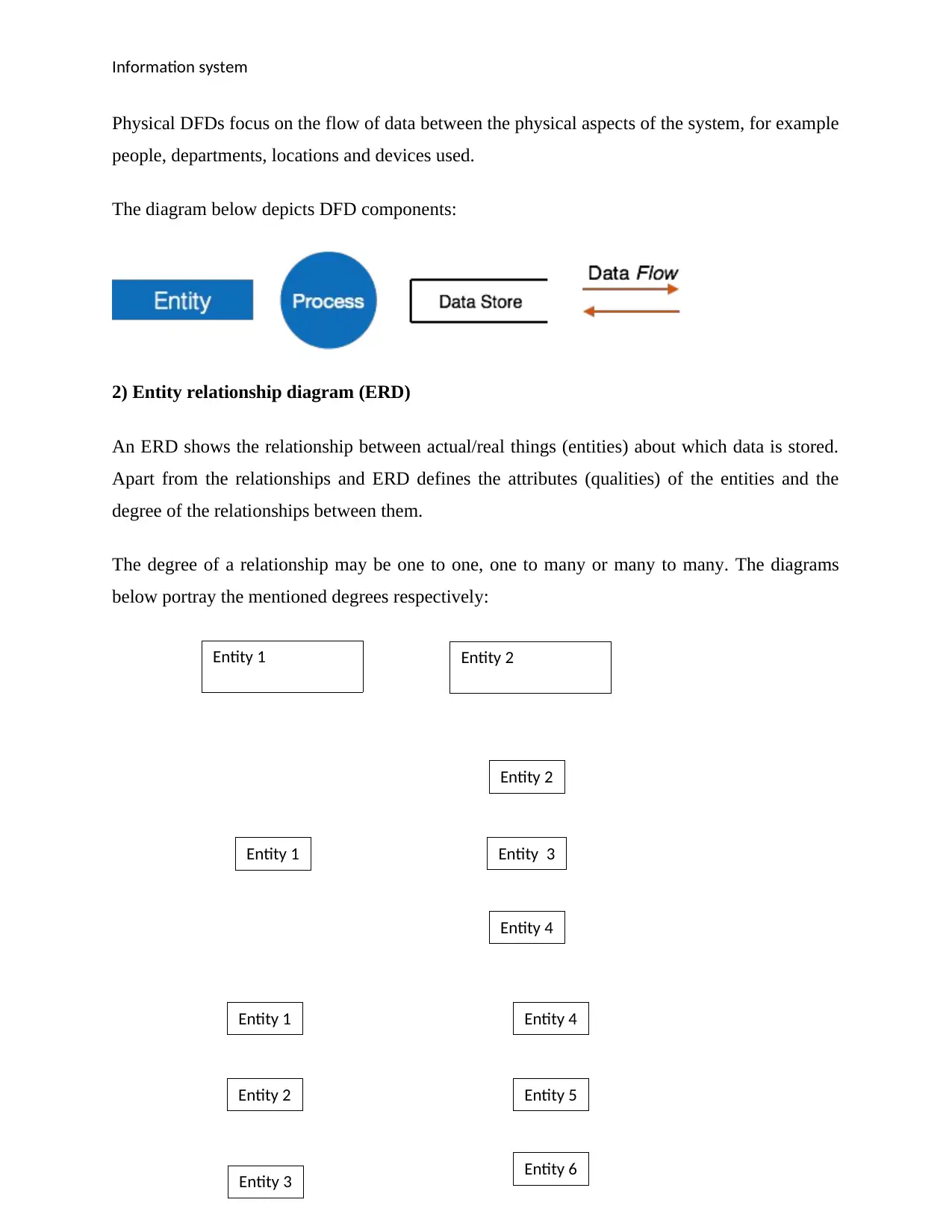
Entity 1
Entity 2
Entity 3
Entity 4
Entity 2
Entity 1
Entity 3
Entity 4
Entity 5
Entity 6
Information system
Physical DFDs focus on the flow of data between the physical aspects of the system, for example
people, departments, locations and devices used.
The diagram below depicts DFD components:
2) Entity relationship diagram (ERD)
An ERD shows the relationship between actual/real things (entities) about which data is stored.
Apart from the relationships and ERD defines the attributes (qualities) of the entities and the
degree of the relationships between them.
The degree of a relationship may be one to one, one to many or many to many. The diagrams
below portray the mentioned degrees respectively:
Entity 1 Entity 2
Entity 2
Entity 3
Entity 4
Entity 2
Entity 1
Entity 3
Entity 4
Entity 5
Entity 6
Information system
Physical DFDs focus on the flow of data between the physical aspects of the system, for example
people, departments, locations and devices used.
The diagram below depicts DFD components:
2) Entity relationship diagram (ERD)
An ERD shows the relationship between actual/real things (entities) about which data is stored.
Apart from the relationships and ERD defines the attributes (qualities) of the entities and the
degree of the relationships between them.
The degree of a relationship may be one to one, one to many or many to many. The diagrams
below portray the mentioned degrees respectively:
Entity 1 Entity 2
⊘ This is a preview!⊘
Do you want full access?
Subscribe today to unlock all pages.

Trusted by 1+ million students worldwide
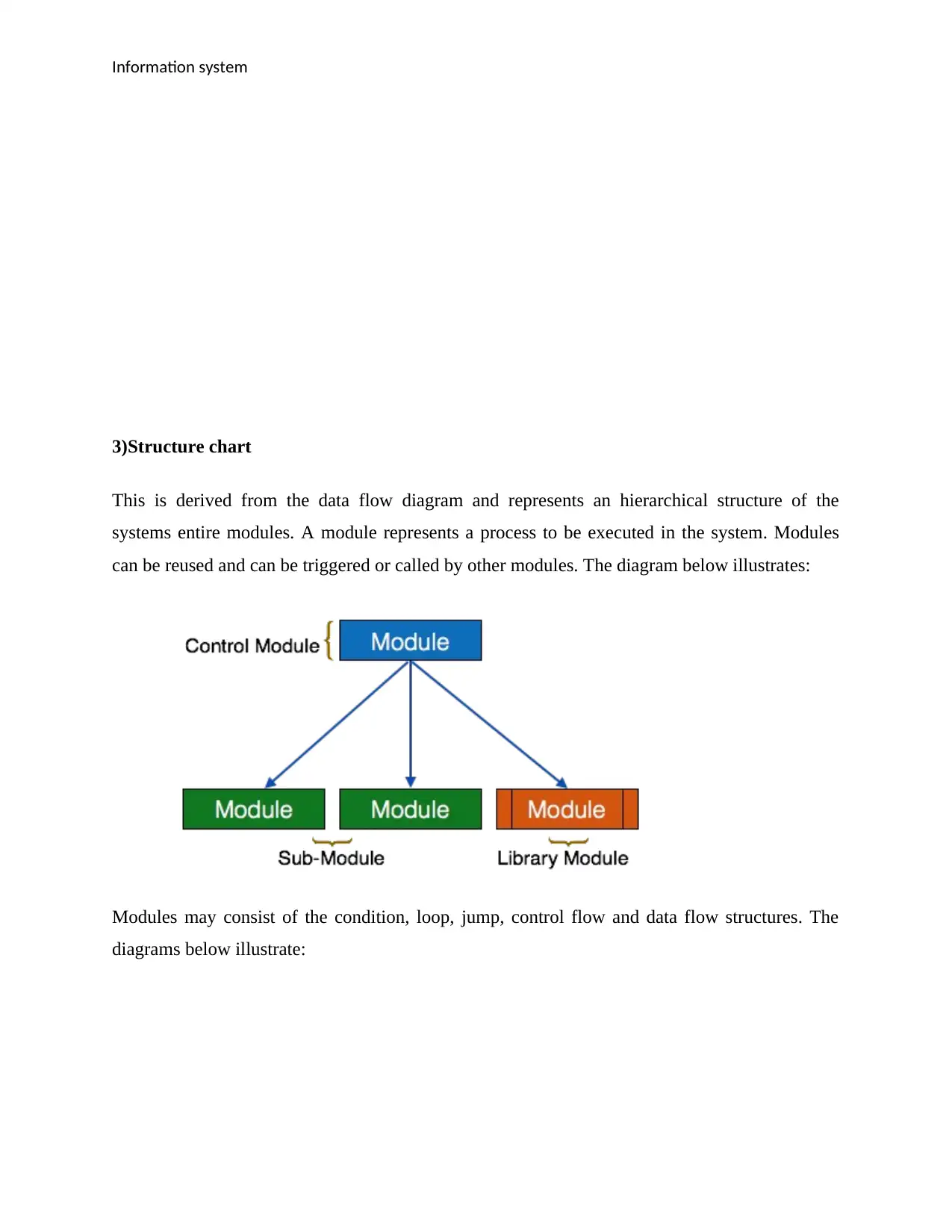
Information system
3)Structure chart
This is derived from the data flow diagram and represents an hierarchical structure of the
systems entire modules. A module represents a process to be executed in the system. Modules
can be reused and can be triggered or called by other modules. The diagram below illustrates:
Modules may consist of the condition, loop, jump, control flow and data flow structures. The
diagrams below illustrate:
3)Structure chart
This is derived from the data flow diagram and represents an hierarchical structure of the
systems entire modules. A module represents a process to be executed in the system. Modules
can be reused and can be triggered or called by other modules. The diagram below illustrates:
Modules may consist of the condition, loop, jump, control flow and data flow structures. The
diagrams below illustrate:
Paraphrase This Document
Need a fresh take? Get an instant paraphrase of this document with our AI Paraphraser
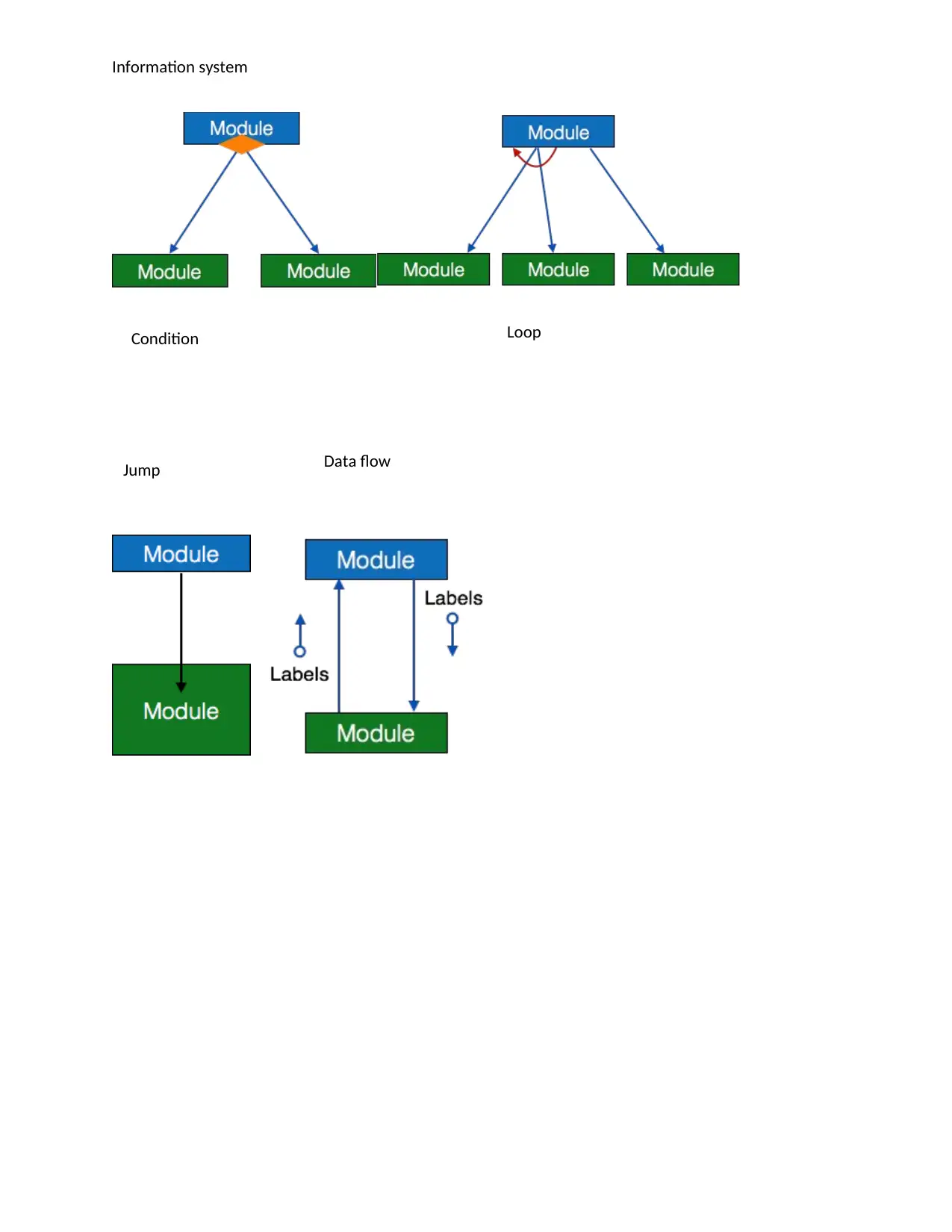
Information system
Condition Loop
Jump Data flow
Condition Loop
Jump Data flow
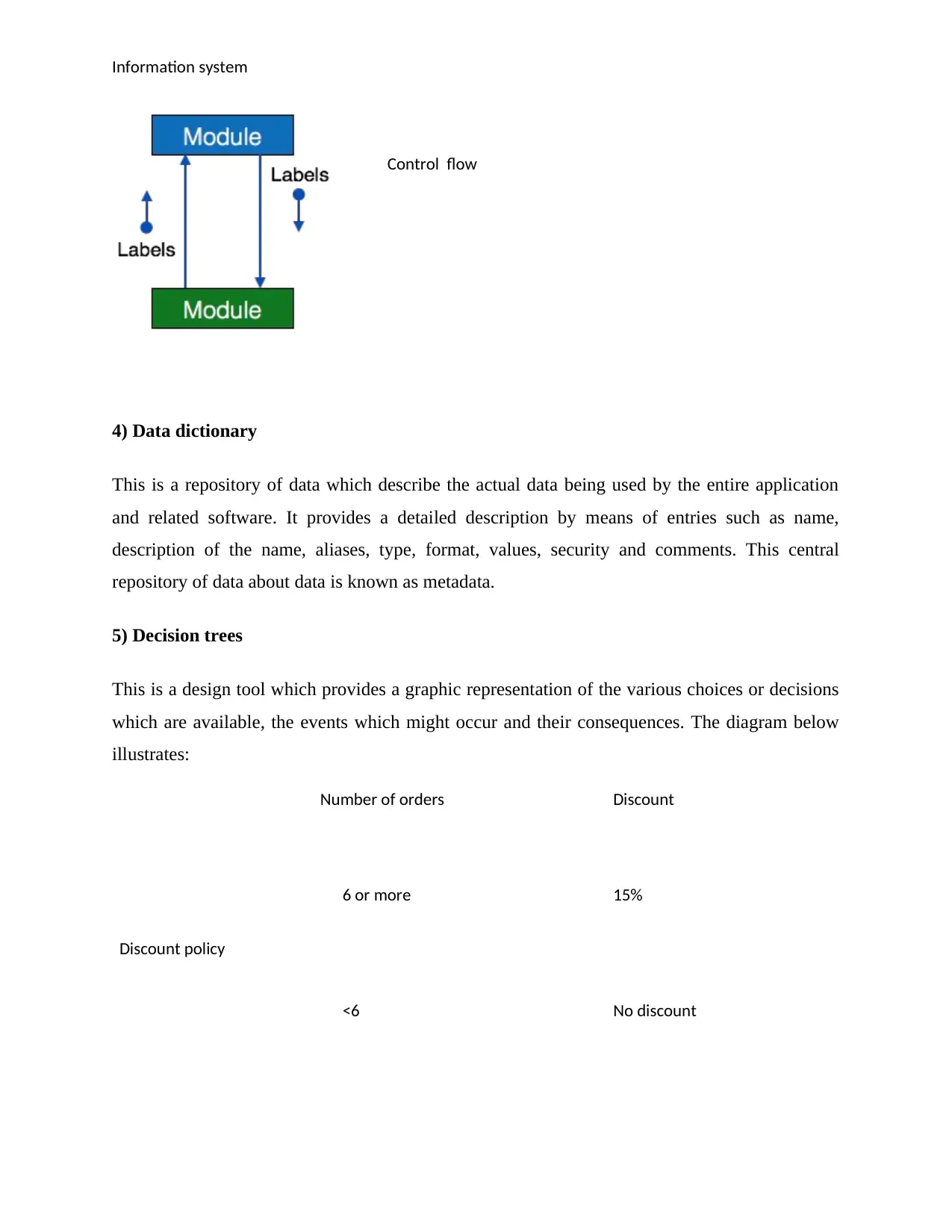
Discount policy
Number of orders
6 or more
<6
Discount
15%
No discount
Information system
4) Data dictionary
This is a repository of data which describe the actual data being used by the entire application
and related software. It provides a detailed description by means of entries such as name,
description of the name, aliases, type, format, values, security and comments. This central
repository of data about data is known as metadata.
5) Decision trees
This is a design tool which provides a graphic representation of the various choices or decisions
which are available, the events which might occur and their consequences. The diagram below
illustrates:
Control flow
Number of orders
6 or more
<6
Discount
15%
No discount
Information system
4) Data dictionary
This is a repository of data which describe the actual data being used by the entire application
and related software. It provides a detailed description by means of entries such as name,
description of the name, aliases, type, format, values, security and comments. This central
repository of data about data is known as metadata.
5) Decision trees
This is a design tool which provides a graphic representation of the various choices or decisions
which are available, the events which might occur and their consequences. The diagram below
illustrates:
Control flow
⊘ This is a preview!⊘
Do you want full access?
Subscribe today to unlock all pages.

Trusted by 1+ million students worldwide
1 out of 13
Related Documents
Your All-in-One AI-Powered Toolkit for Academic Success.
+13062052269
info@desklib.com
Available 24*7 on WhatsApp / Email
![[object Object]](/_next/static/media/star-bottom.7253800d.svg)
Unlock your academic potential
Copyright © 2020–2025 A2Z Services. All Rights Reserved. Developed and managed by ZUCOL.




